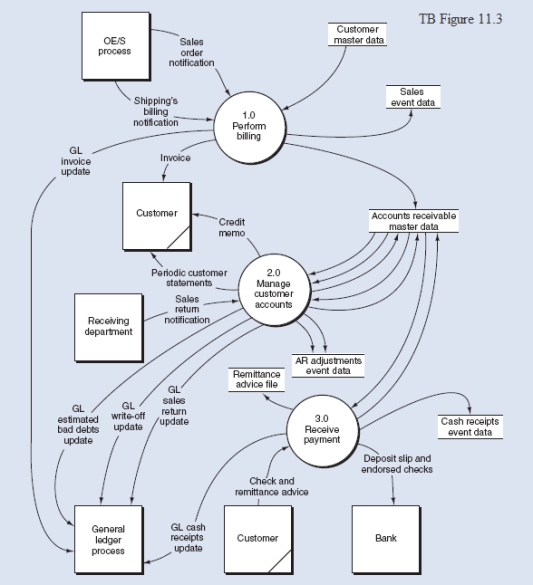Below is the narrative of the "Manage customer accounts" portion of the B/AR/CR process.Narrative Description
Processes 2.1 through 2.3 relate to sales returns adjustments.This process begins when there is notification from the receiving department that goods have been returned by a customer.Subprocess 2.1 obtains data from the accounts receivable master data to validate the return.If the sales return is not valid, it will be rejected (see Reject stub) and processed through a separate exception routine.If the sales return is valid, it is sent to subprocess 2.2 where a credit memo is prepared and sent to the customer, and the accounts receivable master data is updated to reflect the credit.At the same time, the
validated sales return is sent to subprocess 2.3 where a journal voucher is prepared, which is used to create a record in the AR adjustments event data store (i.e., the journal), and the general ledger is notified that a credit memo has been issued.This results in updates to sales returns and allowances and to AR.Process 2.4 is triggered by a periodic review of aging details obtained from the accounts receivable master data.This report would be used to identify and follow up on late-paying customer accounts.One of two types of adjustments might result from this review:
-The recurring adjusting entry for estimated bad debts.-The periodic write-off of "definitely worthless" customer accounts.Like process 2.4, bubble 2.5, "Prepare customer statements," also is triggered by a periodic event that recurs at specified intervals, often on a monthly basis in practice.Details of unpaid invoices are extracted from the accounts receivable master data and are summarized in a statement of account that is mailed (or sent electronically) to customers.Required:
From the DFD in TB Figure 11.3 and the narrative description above, explode bubble 2.0 into a lower-level diagram showing the details of that process. 
Definitions:
Discrimination in Employment
Unfair treatment of employees or job applicants based on race, color, gender, nationality, religion, age, disability, or sexual orientation.
Canadian Charter of Rights and Freedoms
Federal law enacted in 1982, guaranteeing individuals equal rights before the law.
Human Resource Managers
Professionals responsible for overseeing various functions within an organization, including hiring, training, and employee relations.
Canadian Charter of Rights and Freedoms
A foundational legal document in Canada that guarantees fundamental freedoms and rights to its citizens under the constitution.
Q15: The department or function that develops and
Q30: The process of _ involves determining the
Q33: Risks are those events that could have
Q34: In a(n) _ accounts receivable system, the
Q37: The labor force planning data catalogs each
Q41: A control plan that helps ensure the
Q43: In general, adjustments to customer balances in
Q50: The OE/S process addresses the decision needs
Q67: The _ plans and forecasts of an
Q130: A clerk receives checks and customer receipts